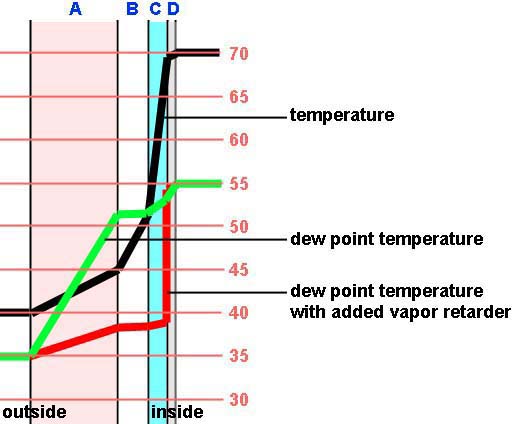Jonathan Ochshorn
Predicting condensation within a wall is complicated; the following example is quite simplistic, as is doesn't account for all sorts of phenomena, including the ability of wet areas to dry out, or the movement of air within the wall itself, which can transport vapor in unexpected ways, or the complex hygrothermal behavior of specific materials. Nevertheless, it may provide some insight into why condensation — when it does occur — does occur.
| concrete | 3.2 perm-in.** | |||
| brick, 4" thick | 0.8 | |||
| concrete block, 8" thick | 2.4 | |||
| glazed tile masonry, 4" thick | 0.12 | |||
| plaster on metal lath, 3/4" thick | 15 | |||
| plaster on wood lath, 3/4" thick | 11 | |||
| gypsum board, unpainted | 50 | |||
| gypsum board, latex paint | 2-3 | |||
| plywood with exterior glue | 0.7 | |||
| polyethylene, 6 mil | 0.06 | |||
| air, still | 120 perm-in.** | |||
| RCPS insulation (EPS) | 2.0-5.8 perm-in.** | |||
| RCPS insulation (XPS) | 1.2 perm-in.** | |||
| aluminum foil | 0.001 | |||
| material | R-value | fraction of total R-value | change in temperature* |
|---|---|---|---|
| 12" brick | 2.4 | 2.4 / 13.85 = 0.173 | 0.173 x 30 = 5.2 |
| 3" air space | 3.0 | 0.217 | 6.5 |
| 2" EPS | 8.0 | 0.578 | 17.3 |
| 1/2" gypsum board | 0.45 | 0.032 | 1.0 |
| totals | 13.85 | 1.00 | 30 |
* the number of degrees change in temperature within a particular material is found by multiplying the fraction of total R-value by the difference between the indoor and outdoor temperature, in this case equal to 70 - 40 = 30 degrees.
The temperature gradient (shown in black in the diagram below) can now be plotted, based on the change in temperature within each material.
For the dew point gradient through the wall, find all the perm-values (see table above) for the constituent materials and compute their relative contribution to the total "inverse" permeance":
| material | perm-value | inverse perm-value | fraction of total inverse perm-values | change in dew point temperature** |
|---|---|---|---|---|
| 12" brick | 0.26 | 1 / 0.26 = 3.85 | 3.85 / 4.875 = 0.790 | 0.790 x 20 = 15.80 |
| 3" air space | 40 | 0.025 | 0.005 | 0.10 |
| 2" EPS | 2.0 | 0.5 | 0.1025 | 2.05 |
| 1/2" gypsum board | 2.0 | 0.5 | 0.1025 | 2.05 |
| totals | 4.875 | 1.00 | 20 |
** the number of degrees change in dew point temperature within a particular material is found by multiplying the fraction of total inverse perm-values by the difference between the indoor and outdoor dew point temperature, in this case equal to 55 – 35 = 20 degrees.
The dew point temperature gradient (shown in green in the diagram below) can now be plotted, based on the change in dew point temperature within each material.

In the diagram above, A, B, C, and D refer to the brick, air space, insulation, and gypsum board respectively. The temperature (degrees Fahrenheit) is plotted along the vertical axis. Note that a red line has also been plotted based on the addition of a polyethylene vapor retarder just inside the gypsum board, assuming a perm value of 0.06, and no effect on the temperature (calculations for the red line are not shown). One can see that condensation may occur inside the wall, where the green line is higher than the black line. However, no condensation will occur when a vapor retarder is added, as the red line is always below the black line.
Copyright
© 2007 J. Ochshorn. First posted: 26 November 2007 | Last Updated: 14 December 2007